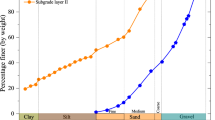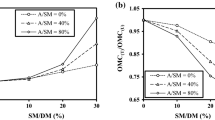Abstract
This paper presents details of a study that deals with determination of engineering properties and microstructural characteristics of a foundation soil (silt) sedimented in Jiangsu Province of China when it is stabilized by lignin-based industrial by-product. A series of laboratory tests were carried out with respect to evaluate the effect of lignin content and curing time on the overall soil properties including Atterberg limits, pH, unconfined compressive strength, stress-strain characteristics, secant modulus, and California bearing ratio. In addition, scanning electron microscopy, X-ray diffraction, and mercury intrusion porosimetry studies were conducted to understand the microstructural characteristics and stabilization mechanism of the stabilized silt. The results reveal that lignin has a great potential to improve engineering properties of silt and shows a promising prospect as a new environmentally friendly soil stabilizer. Curing time and lignin content have significant influence on the basic engineering properties and microstructural characteristics of the lignin stabilized silt. The optimum content of lignin for foundation silt in Jiangsu Province of China is approximately 12%. The precipitated cementing material is formed after stabilization of lignin with a period of curing. The stabilized silt switches over its response from a brittle to ductile material in the presence of lignin. Peak analysis results of the pore-size distribution curves demonstrates that the lignin stabilized silt exhibits bimodal behavior when the lignin content less than 8%, whereas it displays unimodal type when the lignin content is more than or equal to 8%. These observations provide enhanced understanding of lignin-based industrial by-product as a soil stabilizer at the foundation construction.
Similar content being viewed by others
References
ASTM D4972 (2001). Standard test method for pH of soils, ASTM International, West Conshohocken, PA, USA.
ASTM D698-07 (2007). Standard test methods for laboratory compaction characteristics of soil using standard effort [12,400 ft-lb/ft 3 (600 kNm/m 3 )]. ASTM International, West Conshohocken, PA, USA.
ASTM D4219 (2008). Standard test method for unconfined compressive strength index of chemical-grouted soils, ASTM International, West Conshohocken, PA, USA.
ASTM D2487 (2011). Standard practice for classification of soils for engineering purposes (Unified Soil Classification System). ASTM International, West Conshohocken, PA, USA.
Bell, F. G. (1996). “Lime stabilization of clay minerals and soils.” Engineering Geology, Vol. 42, No. 4, pp. 223–237, DOI: 10.1016/0013-7952(96)00028-2.
Blanck, G., Cuisinier, O., and Masrouri, F. (2013). “Soil treatment with organic non-traditional additives for the improvement of earthworks.” Acta Geotechnica, pp. 1–12, DOI: 10.1007/s11440-013-0251-6.
Cai, G., Liu, S., and Puppala, A. J. (2011). “Comparison of CPT charts for soil classification using PCPT data: Example from clay deposits in Jiangsu Province, China.” Engineering Geology, Vol. 121, No. 1, pp. 89–96, DOI: 10.1016/j.enggeo.2011.04.016.
Cai, G., Zhang, T., Puppala, A. J., and Liu, S. (2015). “Thermal characterization and prediction model of typical soils in Nanjing area of China.” Engineering Geology, Vol. 191, pp. 23–30, DOI: 10.1015/j.enggeo.2015.03.005.
Ceylan, H., Gopalakrishnan, K., and Kim, S. (2010). “Soil stabilization with bioenergy coproduct.” Transportation Research Record: Journal of the Transportation Research Board, Vol. 2186, No. 1, pp. 130–137, DOI: 10.3141/2186-14.
Chen, B. (2004). “Polymer-clay nanocomposites: An overview with emphasis on interaction mechanisms.” British Ceramic Transactions, Vol. 103, No. 6, pp. 241–249, DOI: 10.1179/096797804X4592.
Chen, Q. and Indraratna, B. (2014). “Deformation behavior of lignosulfonate-treated sandy silt under cyclic loading.” Journal of Geotechnical and Geoenvironmental Engineering, Vol. 141, No. 1, pp. 06014015.1-5, DOI: 10.1061/(ASCE)GT.1943-5606.0001210.
Chen, Q., Indraratna, B., Carter, J., and Rujikiatkamjorn, C. (2014). “A theoretical and experimental study on the behaviour of lignosulfonatetreated sandy silt.” Computers and Geotechnics, No. 61, pp. 316–327, DOI: 10.1016/j.compgeo.2014.06.010.
Consoli, N. C., Prietto, P. D., and Ulbrich, L. A. (1998). “Influence of fiber and cement addition on behavior of sandy soil.” Journal of Geotechnical and Geoenvironmental Engineering, Vol. 124, No. 12, pp. 1211–1214, DOI: 10.1061/(ASCE)1090-0241(1998)124:12(1211).
Cuisinier, O., Auriol, J. C., Le, Borgne. T., and Deneele, D. (2011). “Microstructure and hydraulic conductivity of a compacted limetreated soil.” Engineering Geology, Vol. 123, No. 3, pp. 187–193, DOI: 10.1016/j.enggeo.2011.07.010.
Ghosh, A. and Subbarao, C. (2006). “Tensile strength bearing ratio and slake durability of class F fly ash stabilized with lime and gypsum.” Journal of Materials in Civil Engineering, Vol. 18, No. 1, pp. 18–27, DOI: 10.1061/(ACE)0899-561(2006)18:1(18).
Gow, A. J., Davidson, D. T., and Sheeler, J. B. (1961). “Relative Effects of Chlorides, Lignosulfonates and Molasses on Properties of a Soil-Aggregate Mix.” Highway Research Board Bulletin, No. 282, pp. 66–83.
Hebib, S. and Farrell, E. R. (2003). “Some experiences on the stabilization of Irish peats.” Canadian Geotechnical Journal, Vol. 40, No. 1, pp. 107–120, DOI: 10.1139/T02-091.
Indraratna, B., Athukorala, R., and Vinod, J. (2012). “Estimating the rate of erosion of a silty sand treated with lignosulfonate.” Journal of Geotechnical and Geoenvironmental Engineering, Vol. 139, No. 5, pp. 701–714, DOI: 10.1061/(ASCE)GT.1943-5606.0000766.
Indraratna, B., Muttuvel, T., and Khabbaz, H. (2009). “Modelling the erosion rate of chemically stabilized soil incorporating tensile forcedeformation characteristics.” Canadian Geotechnical Journal, Vol. 46, No. 1, pp. 57–68, DOI: 10.1139/T08-103.
Indraratna, B., Muttuvel, T., Khabbaz, H., and Armstrong, R. (2008). “Predicting the erosion rate of chemically treated soil using a process simulation apparatus for internal crack erosion.” Journal of Geotechnical and Geoenvironmental Engineering, Vol. 134, No. 6, pp. 837–844, DOI: 10.1061/(ASCE)1090-0241(2008)134:6(837).
Jiang, T. D. (2008). Lignin, Chemical Industry Press, Beijing.
Juang, C. H. and Holtz, R. D. (1986). “Fabric, pore size distribution, and permeability of sandy soils.” Journal of Geotechnical Engineering, Vol. 112, No. 9, pp. 855–868, DOI: 10.1061/(ASCE)0733-9410(1986)112:9(855).
Karol, R. H. (2003). Chemical grouting and soil stabilization (3rd ed.), Marcel Dekker Inc., New York.
Kim, S., Gopalakrishnan, K., and Ceylan, H. (2011). “Moisture susceptibility of subgrade soils stabilized by lignin-based renewable energy coproduct.” Journal of Transportation Engineering, Vol. 138, No. 11, pp. 1283–1290, DOI: 10.1061/(ASCE)TE.1943-5436.0000097.
Lefebvre, G. Z. and Rochelle, P. L. (1974). “The analysis of two slope failures in cemented Champlain clays.” Canadian Geotechnical Journal, Vol. 11, No. 1, pp. 89–108, DOI: 10.1139/T74-007.
Li, X. and Zhang, L. M. (2009). “Characterization of dual-structure pore-size distribution of soil.” Canadian Geotechnical Journal, Vol. 46, No. 2, pp. 129–141, DOI: 10.1139/T08-110.
Locat, J., Bérubé, M. A., and Choquette, M. (1990). “Laboratory investigations on the lime stabilization of sensitive clays: Shear strength development.” Canadian Geotechnical Journal, Vol. 27, No. 3, pp. 294–304, DOI: 10.1139/T90-040.
Mitchell, J. K. and Soga, K. (1976). Fundamentals of soil behavior. John Wiley and Sons, Inc., New York.
Nalbantoglu, Z. and Tuncer, E. R. (2001). “Compressibility and hydraulic conductivity of a chemically treated expansive clay.” Canadian Geotechnical Journal, Vol. 38, No. 1, pp. 154–160, DOI: 10.1139/cgj-38-1-154.
Okagbue, C. O. (2007). “Stabilization of clay using woodash.” Journal of Materials in Civil Engineering, Vol. 19, No. 1, pp. 14–18, DOI: 10.1061/(ASCE)0899-1561(2007)19:1(14).
Perry, J. P. (1977). “Lime treatment of dams constructed with dispersive clay soils.” Transactions of the American Society of Agricultural Engineers, Vol. 20, No. 6, pp. 1093–1099, DOI: 10.13031/2013.35709.
Puppala, A. J. and Hanchanloet, S. (1999). Evaluation of a new chemical (SA-44/LS-40) treatment method on strength and resilient properties of a cohesive soil. 78th Annual Meeting of the Transportation Research Board, Washington, DC, Paper No.990389.
Puppala, A. J., Griffin, J. A., Hoyos, L. R., and Chomtid, S. (2004). “Studies on sulfate-resistant cement stabilization methods to address sulfate-induced soil heave.” Journal of Geotechnical and Geoenvironmental Engineering, Vol. 130, No. 4, pp. 391–402, DOI: 10.1061/(ASCE)1090-0241(2004)130:4(391).
Rollings, R. S. and Burkes, J. P. (1999). “Sulfate attack on cement–stabilized sand.” Journal of Geotechnical and Geoenvironmental Engineering, Vol. 125, No. 5, pp. 364–372, DOI: 10.1061/(ASCE)1090-0241(1999)125:5(364).
Santoni, R. L., Tingle, J. S., and Nieves, M. (2005). “Accelerated strength improvement of silty sand with nontraditional additives.” Transportation Research Record: Journal of the Transportation Research Board, Vol. 1936, No. 1, pp. 34–42, DOI: 10.3141/1936-05.
Santoni, R. L., Tingle, J. S., and Webster, S. L. (2002). “Stabilization of silty sand with nontraditional additives.” Transportation Research Record: Journal of the Transportation Research Board, Vol. 1787, No. 1, pp. 61–70, DOI 10.3141/1787-07.
Sariosseiri, F., and Muhunthan, B. (2009). “Effect of cement treatment on geotechnical properties of some Washington State soils.” Engineering Geology, Vol. 104, No. 1, pp. 119–125, DOI: 10.1016/j.enggeo.2008.09.003.
Sherwood, P. (1993). Soil stabilization with cement and lime: State-ofthe-art review. Transport Research Laboratory, Her Majesty’s Stationery Office, London.
Simms, P. H. and Yanful, E. K. (2001). “Measurement and estimation of pore shrinkage and pore distribution in a clayey till during soil-water characteristic curve tests.” Canadian Geotechnical Journal, Vol. 38, No. 4, pp. 741–754, DOI: 10.1139/cgj-38-4-741.
Tang, Y. X., Liu, H. L., and Zhu, W. (2000). “Study on engineering properties of cement-stabilized soil.” Chinese Journal of Geotechnical Engineering, Vol. 22, No. 5, pp. 549–554, DOI: 10.3321/j.issn:1000-4548.2000.05.008.
Tingle, J. S., Newman, J. K., Larson, S. L., Weiss, C. A., and Rushing, J. F. (2007). “Stabilization mechanisms of nontraditional additives.” Transportation Research Record: Journal of the Transportation Research Board, Vol. 1989, No. 1, pp. 59–67, DOI: 10.3141/1989-49.
Tingle, J. S. and Santoni, R. L. (2003). “Stabilization of clay soils with nontraditional additives.” Transportation Research Record: Journal of the Transportation Research Board, Vol. 1819, No. 1, pp. 72–84, DOI: 10.3141/1819b-10.
Tremblay, H., Duchesne, J., Locat, J., and Leroueil, S. (2002). “Influence of the nature of organic compounds on fine soil stabilization with cement.” Canadian Geotechnical Journal, Vol. 39, No. 3, pp. 535–546, DOI: 10.1139/T02-002.
Vinod, J. S., Indraratna, B., and Mahamud, M. A. A. (2010). “Stabilisation of an erodible soil using a chemical admixture.” Proceedings of the ICE: Ground Improvement, Vol. 163, No. 1, pp. 43–51, DOI: 10.1680/grim.2010.163.1.43.
Washburn, E W. (1921). Note on a method of determining the distribution of pore sizes in a porous material. Proceedings of the National Academy of Sciences of the United States of America, pp. 115–116, DOI: 10.1073/pnas.7.4.115.
Xiao, J., Juang, C. H., Xu, C., Li, X., and Wang, L. (2014). “Strength and deformation characteristics of compacted silt from the lower reaches of the Yellow River of China under monotonic and repeated loading.” Engineering Geology, No. 178, pp. 49–57, DOI: 10.1016/j.enggeo.2014.06.008.
Yao, M., Sun, R. J., Chen, M. Y., and Lai, K. (2009). “Development and utilization of plant cellulouse, lignin and hemicelluloses and so on.” Fine Chemicals, Vol. 26, No. 10, pp. 938–942, DOI: 10.13550/j.jxhg.2009.10.002.
Zhang, L. M., and Li, X. (2010). “Microporosity structure of coarse granular soils.” Journal of Geotechnical and Geoenvironmental Engineering, Vol. 136, No. 10, pp. 1425–1436, DOI: 10.1061/(ASCE)GT.1943-5606.0000348.
Zhang, T., Liu, S., Cai, G., and Puppala, A. J. (2014). “Study on strength characteristics and microcosmic mechanism of silt improved by lignin-based bio-energy coproducts.” ASCE Specialty Conference on Geo-Shanghai 2014: Ground Improvement and Geosynthetics, Shanghai, pp. 220–230, DOI: 10.1061/9780784413401.022.
Zhang, T., Liu, S., Cai, G., and Puppala, A. J. (2015b). “Experimental investigation of thermal and mechanical properties of lignin treated silt.” Engineering Geology, Vol. 196, pp. 1–11, DOI: 10.1016/j.enggeo.2015.07.003.
Zhang, T., Liu, S., Cai, G. Li, J., and Jie, D. (2015a). “Experimental study on relationship between thermal and mechanical properties of treated silt by lignin.” Chinese Journal of Geotechnical Engineering, Vol. 37, No. 10, pp. 1876–1793, DOI: 10.11779/CJGE201510016.
Author information
Authors and Affiliations
Corresponding author
Rights and permissions
About this article
Cite this article
Zhang, T., Cai, G., Liu, S. et al. Engineering properties and microstructural characteristics of foundation silt stabilized by lignin-based industrial by-product. KSCE J Civ Eng 20, 2725–2736 (2016). https://doi.org/10.1007/s12205-016-1325-4
Received:
Accepted:
Published:
Issue Date:
DOI: https://doi.org/10.1007/s12205-016-1325-4




